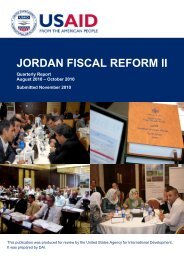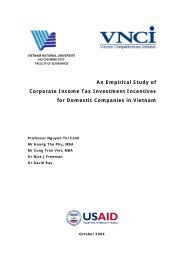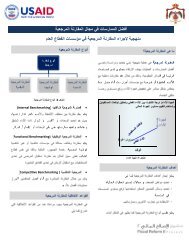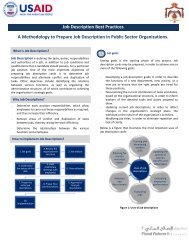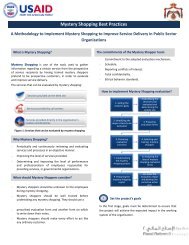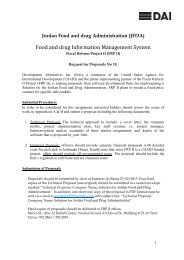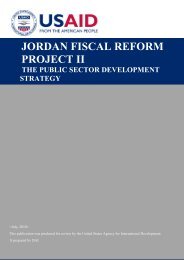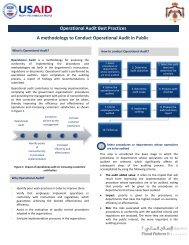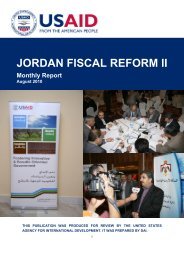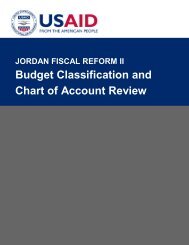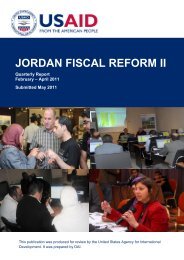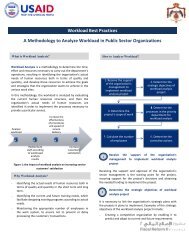Integrated Financial Management Information Systems: A ... - Frp2.org
Integrated Financial Management Information Systems: A ... - Frp2.org
Integrated Financial Management Information Systems: A ... - Frp2.org
Create successful ePaper yourself
Turn your PDF publications into a flip-book with our unique Google optimized e-Paper software.
The training programs, along with change management, should begin as early as possible in the<br />
project, using nationals, who are both committed to the project and to public service, to deliver the<br />
programs as much as possible. This process builds local capacity and helps build confidence among<br />
users, who through this process are re-assured that there will be some constants amid the change.<br />
Given the nature of institutions and organizations, capacity building is a never-ending process. It<br />
needs to be ongoing and permanent. This requires, therefore, establishment of a sound permanent<br />
authority within government, empowered to carry these functions forward.<br />
LEGACY SYSTEMS AND DATA MIGRATION<br />
Existing or “legacy” systems must be addressed as part of the needs assessment. It is also important to<br />
establish if the data can be recovered and transferred into the future system.<br />
There are various degrees of data migration, all depending on the volumes and costs needed to<br />
undertake the exercise. It is very important to bring a creative approach to handling legacy systems<br />
and data migration. Often there are very innovative, creative ways to tackle this aspect the IFMIS<br />
project.<br />
STEP 2 – CREATE A ROADMAP<br />
Once the needs assessment is completed and agreed, the team can set to work on Step 2, the<br />
“Roadmap.” The Roadmap is essentially a strategic plan mapping out how to transform the needs into<br />
a coherent solution, the steps involved, how to address each step, and setting out clear objectives and<br />
milestones for each step of the way. The Roadmap itself should become a measuring stick by which<br />
to measure progress in the process of implementing an IFMIS.<br />
The Roadmap should cover immediate, medium- and long-term tasks and objectives of the IFMIS<br />
project. It should clearly define parameters including the system objective and scope; expected<br />
impact and benefits; critical milestones and success factors; project implementation methodology;<br />
risk assessment and mitigation strategy; estimated cost breakdown by phase; and the financing<br />
arrangements. Agreement on these and other parameters should lead to a written commitment the<br />
cooperating government and corresponding commitments from donors and other external institutions<br />
engaged in the reform process.<br />
The Roadmap (and the needs assessment) should be revisited regularly to ensure that the situation has<br />
not substantially changed, as the time spans involved in implementing an IFMIS are so long that<br />
Government changes are inevitable and these will often lead to structural changes, which will have an<br />
effect on the Roadmap.<br />
Once this phase has been completed, a realistic timeframe has to be worked out through each<br />
successive milestone. There should be no overlapping. Each milestone should follow on from the<br />
next. Here is where the tender process should come into play. Each milestone should become a<br />
specific package, but with provisos, for if the offeror has successfully completed Milestone 1, it<br />
should be allowed to go to the next step automatically for a previously agreed price. If it has<br />
completed the milestone but outside parameters, then the subsequent milestones should be put out for<br />
tender anew.<br />
It must be clearly understood in this approach that all that is being achieved is an “entry-level”<br />
IFMIS. Once such a system is in place, providing it is sustainable and the political will remains, then<br />
the new system will evolve under its own impetus as management demands for information and<br />
processes become increasingly sophisticated.<br />
26 INTEGRATED FINANCIAL MANAGEMENT INFORMATION SYSTEMS: A PRACTICAL GUIDE



